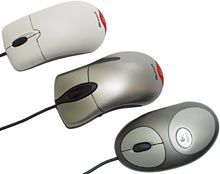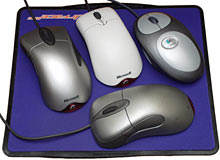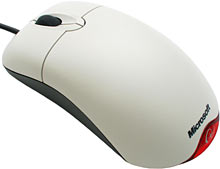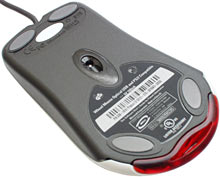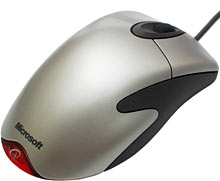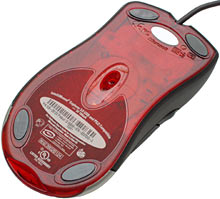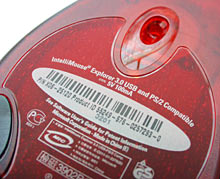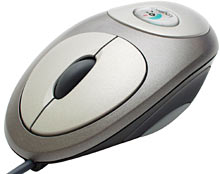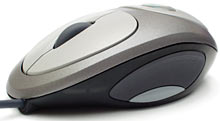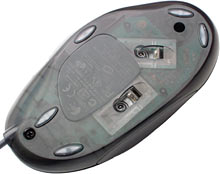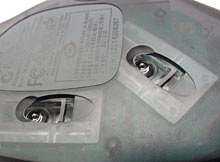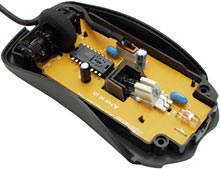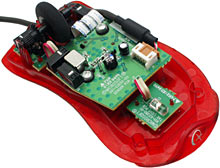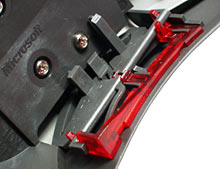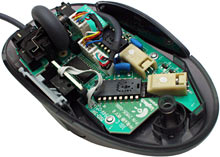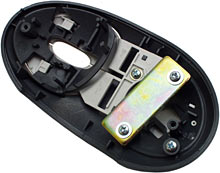
Comparison: Microsoft Wheel Mouse Optical, Microsoft IntelliMouse Explorer 3.0 and Logitech MouseMan Dual Optical
Review date: 24 November 2001.Last modified 03-Dec-2011.
I remember when mouses had balls.
Well, most of 'em did. The ones that didn't were either optical units that needed a special pad, or puck-type widgets for use on graphics tablets. Ordinary personal computer mouses were, overwhelmingly, opto-mechanical, with a rubberised ball and little rollers that collected crud.
We had to clean those rollers, we did. But we didn't mind. We felt lucky to have a mouse at all, we did. Lucky, I say!
Ahem.
Anyhow, these days ball mouses may still be very common, but they're not the preferred pointer-pusher. Pretty much everyone would rather have the new(ish) all-surface optical mouses, which use a tiny camera peering out of the bottom of the mouse to see which way the ground seems to be moving and convert that information into cursor movement.
These optical mouses don't get dirty, they work on uneven surfaces, they're lighter, and they're not painfully expensive, either.
The cheapest opto-mechanical mouses you can get that aren't complete rubbish cost around $AU20; the cheapest opticals are under $AU60. 40 Australian bucks extra isn't much to pay for the advantages of optical.
The trouble with optical mouses, though, is that it's hard to sell people a new one every year. People like me who use a mouse for many hours a day may manage to wear out an optical mouse inside a year, but only by breaking conductors in the cable through repeated bending, or similar relatively far-fetched means.
The sensor doesn't wear out, the LED that illuminates the surface under the mouse has a life expectancy of 100,000 hours, and there are no rollers that get scratched from multiple cleanings and end up unreliable.
And if the cable dies inside a year, us Power Users just get a replacement under warranty. Which is not quite how mouse manufacturers want to shift their product.
So, if you're in the business of making optical mouses and you'd like to actually sell them, rather than give 'em away for free, there are two ways you can go.
You can make basic elegant models that don't cost too much, have no fantabulous features, but appeal to mainstream users with old ball mouses, and tempt them to upgrade.
Or you can take last year's swoopiest, shiniest, most button-encrusted über-mouse, and make a new version that looks and (optionally) works even better, so that the people who Must Have The Best will give their far-from-useless current super-mouse away and get themselves the new model.
Here, for your delectation, are one example of the first strategy in action, and two examples of the second.
Thanks to the wonders of USB, it's easy to plug in an arbitrary number of mouses simultaneously, for ease of comparison. If your USB hub's only a couple of feet from your mousemat then you'll end up with an imposing cable jungle, but such is life.
Let's start with the simple mouse.
Wheel Mouse Optical
This is Microsoft's current entry level optical wheelie-mouse, but it's still not a bargain-basement product. When I first wrote this review Aus PC Market were selling it for $AU75.90 (however, they no longer sell it).
For your money you get two normal buttons and one clickable wheel, a combination USB and PS/2 interface (with plug adapter for PS/2 mode), and the usual Microsoft twin-LED design. One LED lights the surface under the camera, and the other one illuminates the red tail-light at the back of the mouse, for no reason other than cool looks. Oh, all right, it tells you whether the mouse's USB driver is happy, as well, but the underside light doesn't glow when the mouse isn't working, either.
Apart from the tail-light, there's nothing in the Wheel Mouse Optical design that's not purely functional. It's not an anonymous bar-of-soap mouse, but neither does it have any out-there asymmetric design or styling extras.
Want a show-off see-through base-plate? Tough.
This mouse's slightly off-white top and slate-grey base mean it would fit rather nicely into the decor of the space station in 2001, though. I like it.
The Wheel Mouse Optical is an easy mouse to forget you're using. Unless you're accustomed to something really peculiar, there's no learning curve involved in getting comfortable with this mouse. Big-but-not-huge buttons which have a definite but not excessive click, positive wheel action that's neither stiff nor overly touchy, and light weight, too.
The Wheel Mouse Optical feels a bit longer than your average mouse, but there's no big bulge towards the rear to irritate people with small hands. And because it's symmetrical, left-handed users are welcome. Which is more than can be said for the other two mouses in this comparison.
On the down side, the Wheel Mouse Optical's sensor can't keep up if you flick the mouse really quickly; it just hops a bit and the pointer stays more or less where it was. For almost all purposes, this is irrelevant, but if you're an enthusiastic player of action games, it doesn't hurt to have a mouse that can keep up with really fast movement.
That aside, there's nothing not to like about this mouse. Decent price, very comfortable, works fine on PC or Mac with or without Microsoft's fancy IntelliPoint software installed.
If you've already got a working optical mouse, though, there's not much reason to upgrade to this one.
So let's get freaky.
IntelliMouse Explorer 3.0
If the Wheel Mouse Optical were a car, it'd be a brand new Toyota Camry.
But if the new IntelliMouse Explorer...
...were a car...
...it'd be a concept vehicle with millimetre-thick tyres and radar collision avoidance.
The old Explorer still looks pretty nifty, but the new one is lower, sleeker and shinier. The basic design is very similar - this is a tilted, asymmetrical, right-hand-only mouse with two thumb buttons on the left side - but the new version has this NCC-1701E thing going on.
The version 2 Explorer looked the same as the version 1 one, but it had a better sensor with a higher photo rate. The original IntelliEye mouses took 1500 images per second of the surface below them; the second version ones took 2000. The reason for doing this was partly to help the mouse handle lousy surfaces - translucent, reflective and similarly hard-to-look-at materials - and partly to improve its high speed performance.
The v1.0 IntelliEye mouses, and other opticals of the same vintage, could very easily be made to skip if you moved them quickly; version 2 models, including the Wheel Mouse Optical, are better but not tremendously so. When you move the mouse fast enough that it can't see enough similarity between successive images of the surface beneath it to be able to tell what's going on, it skips.
Some very important tasks become impossible when you can't move your mouse really quickly. Well, unless you cheat, anyway.
The v3.0 Explorer's micro-camera takes 6000 images per second, and that seems to have completely cured the skipping problem.
Aside from the "Version 3.0" text next to the sensor lens, there's nothing new to see on the underside. But you can pick the difference when you use it, if you whip it around fast.
Most people won't notice the problem in real life. I play FPS games, and I can't say I noticed any control issues with the v2.0 mouses. But, for what it's worth, I can't make the new Explorer skip at all, no matter how hard I try.
I like the feel of the Explorer 3.0, too. It's a bit slimmer than the old Explorer - which doesn't feel as chunky as it looks, but which is still a large mouse. The new Explorer's smaller side buttons are harder to press by accident, and the other buttons and wheel feel nice, as well. I like the fact that the main buttons are now slightly concave.
The difference between the Explorers is a subtle one, though. If you just dropped your hand onto either of them in the dark, you'd have a hard time telling them apart without fondling the buttons a bit.
The new Explorer is, of course, another USB-and-PS/2 unit, which can be used on USB-equipped Macs as well as PCs.
You're looking at around $AU100 for the Explorer 3.0. If you've got a version 1 or 2 Explorer and don't have skipping problems then there's no reason to upgrade, but you may find yourself wanting to anyway.
Want something even weirder? Can do.
Double barrelled
If this mouse looks a bit familiar, it's because Logitech have used this shape of casing before. Their Cordless MouseMan Optical (which I looked at most recently here) is this shape. But this mouse is the MouseMan Dual Optical, a quite different beastie.
It's another USB-and-PS/2 unit, it's got the same wheelie-mouse-plus-one-side-button control layout as the Cordless MouseMan Optical, and its official US retail price is $US49.95. You can find it locally for about $AU85 ex shipping.
When you flip it over, though...
...there's more going on than you might expect.
These twin sensors are supposed to deliver "maximum precision", for "intelligent tracking on a variety of surfaces", with a "dynamic transition system for increased precision".
Basically, the deal seems to be that whichever sensor has the best idea of what's going on is the one the mouse listens to.
Oh, and on their page for it, Logitech go on to say that the dual sensor mouse is "designed for real hands".
Well, that's a relief. All of those mouses that're designed for fictional hands really bother me.
In use, there's nothing dramatically different about the dual sensor MouseMan. It tracks just fine, and it's as skip-proof as the v3.0 Explorer. It works well on irregular surfaces, but so do the other two mouses in this comparison.
The early model all-surface opticals were really lousy on translucent surfaces, like for instance white Everglide mousemats, but all three of these mouses work almost acceptably on them - you wouldn't do it by choice, but if you're forced to, it pretty much works. None of these mouses work on a mirror or a clear pane of glass, but on any surface where normal people use a mouse, they're all the same.
Perhaps if you spend a lot of time using a mouse on shag pile carpet or leaf litter or coffee grounds or something, then the Dual Optical will be obviously superior.
I'm used to the Explorer, so I'm not nuts about the MouseMan's shape. It's not uncomfortable, it's not awkward, but the button position and size is different. I'm used to high-mounted side buttons, so I tend to press the low-mounted side button on the MouseMan by mistake.
If you prefer a quiet mouse, you'll like the MouseMan Dual Optical; its microswitches are much quieter than the Microsoft ones. Its scroll wheel's got a subtler, less positive feel to it as well; which you prefer is a matter of taste.
Even if you're an habitual Explorer user, you could get used to these ergonomic features easily enough. What you might find more annoying about the MouseMan Dual Optical is that it weighs noticeably more than the Microsoft opposition.
I thought that was because of the extra hardware inside, but I was wrong.
Cracking the cases
If you haven't taken the top off, you haven't reviewed a mouse.
There's nothing very special about the guts of the Wheel Mouse Optical, but getting at them is trickier than usual. The mouse has screws under its back two feet, but it's also got clips under its front two feet. So you have to completely de-foot the mouse to get it apart, and then fiddle with a little flat-head screwdriver or similar prodder in order to get the clips to release.
The lid of the Wheel Mouse Optical's entirely unremarkable, but its tail-light piece is a separate bit of plastic. If you're the type that's itching to implant more LEDs or dye the thing purple or install a cooling fan or something, this may matter to you.
The new model Explorer is held together with four screws, all under the feet, as bleeding usual. Inside it, the only obvious innovation is that the side button microswitches...
...are pressed by a somewhat cooler looking hinged-button arrangement than the old Explorer used. The Explorer 3.0's side buttons are even lighter to the touch than the bigger buttons on the older Explorer.
Getting into the Dual Optical is refreshingly easy. You don't have to peel any feet off, because the two lid-fixing screws are out in the open. The Dual Optical's five tiny feet wouldn't be adequate to cover a screw, anyway.
Inside, the circuit board is understandably somewhat congested. But the interesting part is much less complex.
Inside the lid, there's a simple screwed-on chunk of steel.
That's why this mouse is noticeably heavier than the Microsoft product; it's got a Make The Product Feel Solid Weight in it.
Since it's dead easy to take off the Dual Optical's lid without mangling the feet, removing this weight would be a simple task for anybody who'd rather have a lighter mouse.
Microsoft's original IntelliMouse with IntelliEye (which I reviewed some time ago here) has a similar lump of metal in it, and is similarly user-lightenable.
Overall
If you have to use your mouse on non-optimal surfaces - the top of a somewhat shiny equipment case, your leg, carpet - then the dual sensor MouseMan seems to stand the best chance of keeping your pointer on track. On any proper mousing surface that isn't shiny or see-through, though, there's no difference between the basic tracking abilities of any of these mouses, and the Explorer 3.0 handles fast movement just as well as the Dual Optical.
The plain Wheel Mouse Optical deserves to be made the ISO Standard Optical Mouse. It's very pleasingly styled, you don't have to be right handed to use it, and it tracks more than well enough for most users. If you want to stock an office with mouses, you could do a lot worse than shell out for a crate of these.
If you look past the dual-sensor hype, there's definitely nothing wrong with the MouseMan Dual Optical, and you may well prefer it to the Explorer 3.0. The only way to tell for sure is by using both mouses. But no right-hander is likely to be particularly annoyed by either.
There are, by the way, new features in the IntelliPoint driver software that Microsoft are bundling with their current mouses, but there's no need to spend a cent to get that. You can get the new scroll-wheel-acceleration feature and so on for free by downloading IntelliPoint 4 from Microsoft here. Logitech's MouseWare software can, similarly, be had for nothing from here.
Which of these three would I use?
Well, I'm used to the Explorer, and the new Explorer's nicer. So I'll switch to it.
But really, all three of these mouses are winners. Check 'em out.
Microsoft's page for the Wheel Mouse Optical
Microsoft's page for the IntelliMouse Explorer
Logitech's page for the MouseMan Dual Optical
Buy a mouse!
Aus PC Market doesn't sell these products
any more (click
here to see their current mouse-related products), but you can still try a price
search at
DealTime!)
